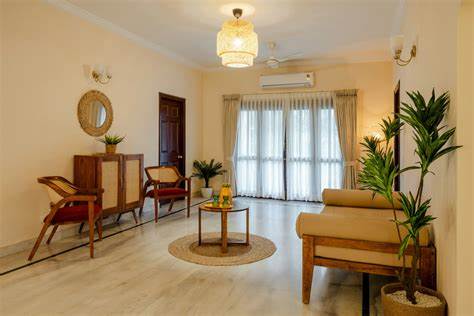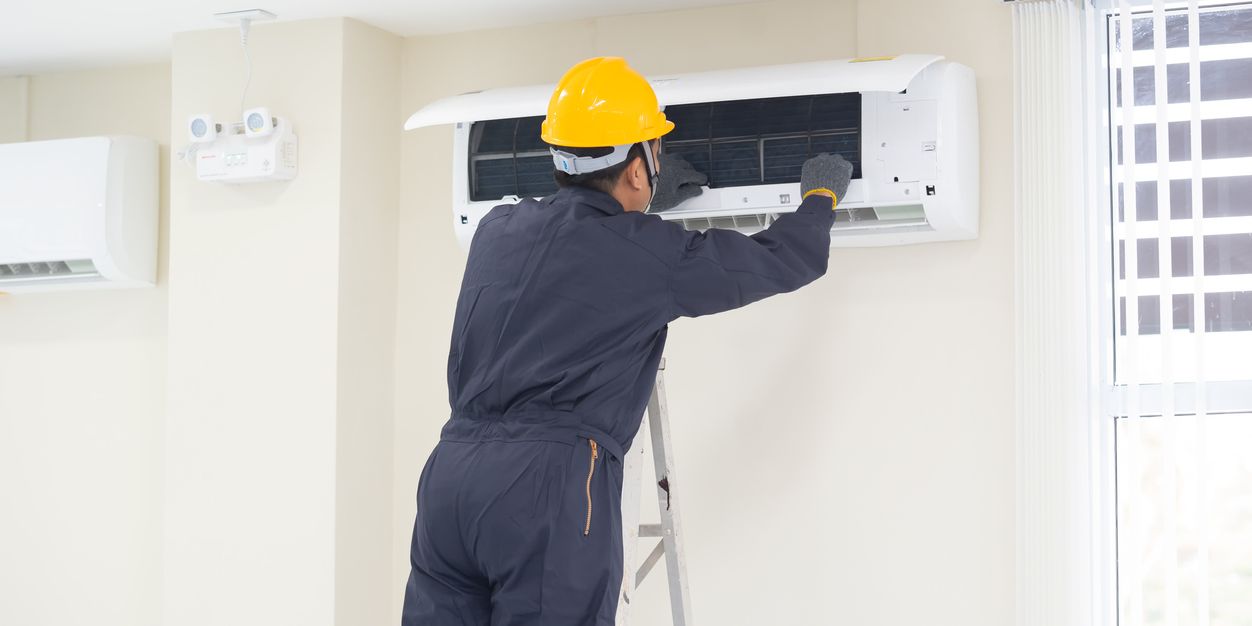Ductless air conditioning systems, often overshadowed by their more traditional counterparts with extensive ductwork, carve out a unique space in the HVAC world with their efficiency and versatility. This distinctive approach to climate control sets them apart, offering a cooling solution that stands out as a category of its own within the realm of air conditioning. Key types of ductless systems include Single-Zone and Multi-Zone configurations, each known for their specific applications.
The Single-Zone ductless system shines in its simplicity and is perfect for targeting individual rooms or spaces, while the Multi-Zone system offers a comprehensive solution that can cool multiple areas independently. Delving deeper, each configuration of a ductless air conditioning system brings its own set of benefits, installation considerations, energy efficiency levels, and suggestions for optimal use cases. The following sections will explore these elements in detail, providing a deeper insight into what makes ductless air conditioning systems a smart and adaptable choice for both homeowners and businesses alike.
What is a ductless air conditioning system?

A ductless air conditioning system, also known as a mini-split, is a highly efficient and flexible cooling solution that operates without the need for extensive ductwork. It consists of two main parts: an indoor unit that releases cool air into the room and an outdoor unit that expels heat outside. These two units are connected by a small conduit that houses the power cable, refrigerant tubing, and a condensate drain.
This setup allows for a simpler installation process compared to traditional systems and offers the advantage of cooling individual rooms or zones within a building. Ideal for spaces where adding ductwork is impractical, ductless air conditioning systems provide an effective way to manage indoor temperatures and enhance comfort without the complexities and costs associated with more conventional HVAC systems.
Why choose a ductless system over traditional systems?
Choosing a ductless system over traditional HVAC systems comes with multiple benefits. Firstly, ductless systems are known for their cost-effectiveness in the long run. They consume less energy, directly reducing monthly utility bills.
Secondly, their space-saving design is ideal for small homes or rooms where ductwork is impractical or impossible. This makes them a versatile option for any space. Lastly, ductless systems offer flexibility in zoning, allowing personalized temperature control in different rooms or areas.
This means you can cool or heat specific zones of your home without affecting the entire house, leading to enhanced comfort and further energy savings. These advantages make ductless air conditioning systems a smart choice for those looking to upgrade their cooling and heating solutions.
Cost-effectiveness in the long run
Ductless systems stand out for their energy efficiency, which translates into significant savings on utility bills over time. This cost-effectiveness is a key advantage for both homeowners and businesses looking to optimize their energy expenditure.
Space-saving design ideal for small homes
The compact size of ductless air conditioners makes them especially suited for small homes and spaces where traditional ductwork is not feasible. This space-saving design ensures that every inch of your home is utilized efficiently, without the need to accommodate bulky ducts.
Flexibility in zoning allows personalized temperature control
Ductless systems offer unparalleled flexibility in zoning, allowing for personalized temperature control in different rooms or areas. This means you can create a customized climate in each zone, enhancing comfort while also reducing energy consumption by only cooling or heating spaces in use.
How does a ductless air conditioning system work?

A ductless air conditioning system functions through a two-part mechanism involving an indoor unit and an outdoor unit, connected by refrigerant lines. The indoor unit captures warm air from the room, cools it, and then releases it back into the space. Meanwhile, the outdoor unit expels the absorbed heat outside and circulates the refrigerant necessary for cooling.
This process is efficient and allows for precise temperature control within different zones of a home or building, without the need for extensive ductwork. This system’s design not only makes it versatile for various settings but also contributes to its energy efficiency and ease of installation.
Indoor unit captures warm air and cools it
The indoor unit efficiently captures warm air from the room, cools it down through a refrigeration cycle, and then circulates the chilled air back into the space, significantly enhancing indoor comfort.
Outdoor unit expels heat and circulates refrigerant
Functioning as the system’s heat ejector, the outdoor unit is tasked with expelling the absorbed indoor heat to the outside environment. It also plays a pivotal role in circulating the refrigerant, which is vital for the cooling process to occur between the indoor and outdoor units.
Refrigerant lines connect indoor and outdoor units
Refrigerant lines serve as the critical conduits between the indoor and outdoor units, facilitating the seamless flow of refrigerant. This connection is essential for the continuous cycle of absorbing indoor heat and releasing it outdoors, ensuring the system’s efficient operation.
Main components of a ductless air conditioning system
The effectiveness of a ductless air conditioning system hinges on its core components: the compressor, air-handling units, and remote control. The compressor, often referred to as the heart of the system, is located in the outdoor unit and plays a pivotal role in circulating refrigerant between the indoor and outdoor units. The air-handling units, installed inside the home, are responsible for distributing the cooled air into the designated spaces.
Lastly, the remote control offers users an easy way to adjust temperatures and settings, ensuring optimal comfort and efficiency. Together, these components work in harmony to provide a seamless and efficient cooling solution.
Compressor, the heart of the system
The compressor stands as the central component of a ductless air conditioning system, aptly described as its heart. It plays a pivotal role in pumping and circulating the refrigerant between the indoor and outdoor units, facilitating the essential cooling cycle.
Air-handling units for distributing cooled air
Air-handling units, strategically placed within the indoor environment, are tasked with the crucial role of distributing the cooled air evenly across the room or designated zones, ensuring optimal comfort levels are achieved throughout the space.
Remote control for easy temperature adjustments
Equipped with a remote control, users gain the convenience of effortlessly adjusting the temperature and operational settings of their ductless system from anywhere in the room, allowing for personalized comfort with just the touch of a button.
Installation requirements for a ductless system

Installing a ductless air conditioning system requires meeting specific conditions to ensure optimal performance and efficiency. Firstly, identifying a suitable wall space for mounting the indoor units is crucial, as they need to be placed in a location that allows for effective air distribution throughout the room. Secondly, understanding the electrical requirements is essential, as different models and brands may have varying needs for power supply and circuitry.
Lastly, the proximity between the indoor and outdoor units plays a significant role in the system’s efficiency; they must be installed close enough to allow for easy connection of refrigerant lines but also positioned to facilitate proper heat dissipation from the outdoor unit. Meeting these requirements during AC installation can significantly impact the system’s performance, comfort levels, and energy consumption.
Suitable wall space for mounting indoor units
Identifying a suitable wall space is crucial for the installation of indoor units. This area needs to support the unit’s weight and allow for optimal air circulation, ensuring the system delivers efficient cooling without obstruction.
Electrical requirements vary by model and brand
The electrical requirements for ductless systems can differ across models and brands. It’s essential to verify these details beforehand to ensure compatibility with your home’s electrical infrastructure, safeguarding against installation complications.
Also Read: Best Central AC Brands
Proximity to the outdoor unit for efficiency
Maintaining the right proximity between the indoor and outdoor units is vital for maintaining system efficiency. Strategic placement minimizes the length of refrigerant lines and optimizes heat expulsion, crucial for the ductless system’s optimal performance.
Maintenance and care tips for ductless systems
To ensure the longevity and efficiency of a ductless air conditioning system, regular maintenance and care are essential. Key practices include regular cleaning of filters to maintain air quality and system efficiency. Filters should be checked and cleaned monthly to prevent dust and debris buildup.
Additionally, checking for leaks in the refrigerant lines is crucial for maintaining the system’s performance and efficiency. Early detection of leaks can prevent more significant issues down the line. Lastly, scheduling professional maintenance checks annually can help identify potential problems before they escalate, ensuring the system operates at optimum levels.
Adhering to these maintenance and care tips can significantly extend the life of a ductless system and enhance its performance.
Also Read: Best Air Filter For Home
Regular cleaning of filters to maintain air quality

Regular cleaning of filters is a critical step in preserving both the air quality within your space and the overall efficiency of your ductless system. Clean filters facilitate optimal airflow and efficiency, preventing the recirculation of dust and potential allergens, thus ensuring a cleaner, healthier indoor environment.
Checking for leaks to ensure system efficiency
Checking for leaks in the system’s refrigerant lines is essential for ensuring its efficiency. Leaks can significantly impair cooling performance and lead to increased operational costs. Timely detection and repair of these leaks are crucial for maintaining the system’s optimal functionality and efficiency.
Professional maintenance checks for longevity
Scheduling professional maintenance checks at least once a year is crucial for the longevity and reliability of your ductless system. These checks help in early identification of potential issues, allowing for preventive measures to be taken before they escalate into major problems, thereby extending the system’s lifespan and ensuring continuous, efficient operation.
Potential drawbacks of a ductless system
While ductless air conditioning systems offer numerous advantages, there are potential drawbacks to consider. One of the main concerns is the initial installation cost, which can be higher than traditional systems, especially when multiple indoor units are required for zoned cooling. Additionally, the aesthetic impact on interior design is a consideration; the indoor units are visible and may not seamlessly integrate with every decor style.
Finally, limited heating capability in extremely cold climates is another factor; while many ductless systems offer heating as well as cooling, their efficiency can decrease in very low temperatures, making them less suitable as the sole heating source in regions with harsh winters. Understanding these limitations is crucial for homeowners and businesses to make informed decisions based on their specific needs and environmental conditions.
Initial installation cost can be high
The initial installation cost for ductless air conditioning systems can be notably higher than that of traditional HVAC systems. This cost disparity becomes more pronounced when installing multiple indoor units to achieve zoned cooling, necessitating a considerable upfront financial commitment.
Aesthetic impact on interior design
The aesthetic impact on interior design is a consideration for ductless systems. The indoor units, while compact, are visible within the living space and may not seamlessly integrate with every interior design scheme, potentially affecting the room’s visual harmony.
Limited heating capability in extremely cold climates
Ductless systems, although capable of providing both cooling and heating, may exhibit limited heating capability in extremely cold climates. Their efficiency as a primary heat source can diminish in very low temperatures, rendering them less effective during severe winter weather.
Energy efficiency of ductless air conditioning systems

Ductless air conditioning systems are celebrated for their energy efficiency, significantly surpassing that of traditional HVAC systems. This efficiency is primarily due to their ability to cool specific zones or rooms, reducing wasteful cooling of unoccupied spaces. Additionally, the incorporation of inverter technology in many ductless models allows these systems to adjust their output to match the cooling demand precisely, further minimizing energy consumption.
Moreover, the targeted cooling approach of ductless systems means that energy isn’t wasted cooling areas that don’t need it, leading to lower utility bills and a reduced environmental impact. This makes ductless systems an environmentally friendly and cost-effective choice for climate control.
Lower energy consumption compared to traditional systems
Ductless air conditioning systems excel in lower energy consumption relative to traditional HVAC systems. This heightened efficiency stems from their capability to selectively cool occupied areas, thereby eliminating the inefficiency linked to cooling vacant spaces.
Use of inverter technology reduces energy waste
Incorporating inverter technology, ductless systems significantly diminish energy waste. This advanced technology allows the system to fine-tune its cooling output to precisely meet the current demand, ensuring operational efficiency without excess energy expenditure.
Zone cooling reduces unnecessary energy use
Zone cooling is a hallmark of ductless systems, enabling targeted cooling of specific areas or zones within a premises. This strategic approach ensures that energy is utilized judiciously, cooling only the spaces in use and substantially reducing unnecessary energy consumption.
Choosing the right size ductless system for your space
Selecting the appropriate size for a ductless air conditioning system is crucial for achieving optimal comfort and efficiency in your space. The process involves calculating the required BTU (British Thermal Units), which is essential for determining the system’s cooling capacity needed to efficiently cool a particular area. Factors such as room size, sun exposure, and insulation levels play a significant role in this calculation.
Rooms with more sunlight or poor insulation may require systems with higher BTU ratings to maintain comfortable temperatures. Additionally, a professional assessment can provide valuable insights into the best unit placement and size, ensuring that the chosen system matches the specific cooling requirements of the space. Proper sizing is key to maximizing energy efficiency, reducing operational costs, and ensuring a comfortable environment.
Calculating the required BTU for efficient cooling
Calculating the required BTU is essential for ensuring that a ductless system can cool a space efficiently. This step helps to match the system’s cooling capacity with the specific needs of the area, optimizing performance and energy usage.
Considering room size and sun exposure
Room size and sun exposure are critical factors in selecting the right ductless system. Spaces that are larger or receive more sunlight typically require units with higher BTU ratings to effectively maintain comfortable temperatures.
Professional assessment for optimal unit placement
Seeking a professional assessment is invaluable for determining the most effective placement and sizing of a ductless unit. Professionals consider various factors, including room layout and insulation quality, to recommend a system that best suits the space’s unique requirements.
The future of ductless air conditioning technology

The future of ductless air conditioning technology appears promising, with advancements focusing on increasing energy efficiency, integrating with smart home systems, and improving refrigerant types to reduce environmental impact. Innovations in energy efficiency aim to further reduce the operational costs and carbon footprint of these systems, making them even more appealing to environmentally conscious consumers. The integration with smart home technology promises to enhance user convenience and control, allowing for more precise temperature management and potentially even predictive maintenance capabilities.
Additionally, ongoing research into new refrigerant types seeks to minimize the environmental harm caused by cooling agents, aligning ductless systems with global sustainability goals. These advancements suggest a bright future for ductless technology, one that continues to offer effective cooling solutions while increasingly addressing environmental concerns.
Advances in energy efficiency
Future advances in energy efficiency promise to elevate ductless air conditioning systems to new heights of eco-friendliness and cost-effectiveness. These developments aim to slash energy use while enhancing cooling capabilities, offering significant benefits for both the environment and consumers.
Integration with smart home systems
The integration with smart home systems represents a significant leap forward in the way ductless air conditioners are controlled and managed. This integration is expected to offer unprecedented levels of convenience and precision in temperature regulation, making homes smarter and more comfortable.
Improvements in refrigerant types for lower environmental impact
Continued improvements in refrigerant types are crucial for reducing the ecological footprint of ductless air conditioning systems. By adopting refrigerants with a lower global warming potential, the industry is moving towards more sustainable and environmentally friendly cooling options.
Transform Your Space with Advanced Ductless Air Conditioning
Ductless air conditioning systems provide a unique and efficient solution for modern climate control needs. Their versatility makes them ideal for both single-room applications and multi-zone setups, offering tailored comfort with advanced energy efficiency. The ongoing advancements in smart home integration and eco-friendly refrigerants further enhance their appeal, promising even greater convenience and sustainability.
Our expert team can help you select and install the perfect system to meet your needs, ensuring optimal performance and energy savings. Contact Callidus Air today to explore our range of ductless air conditioning solutions and take the first step towards a smarter, more comfortable home or business.

